display TOYOTA TUNDRA 2019 Accessories, Audio & Navigation (in English)
[x] Cancel search | Manufacturer: TOYOTA, Model Year: 2019, Model line: TUNDRA, Model: TOYOTA TUNDRA 2019Pages: 282, PDF Size: 6.64 MB
Page 137 of 282
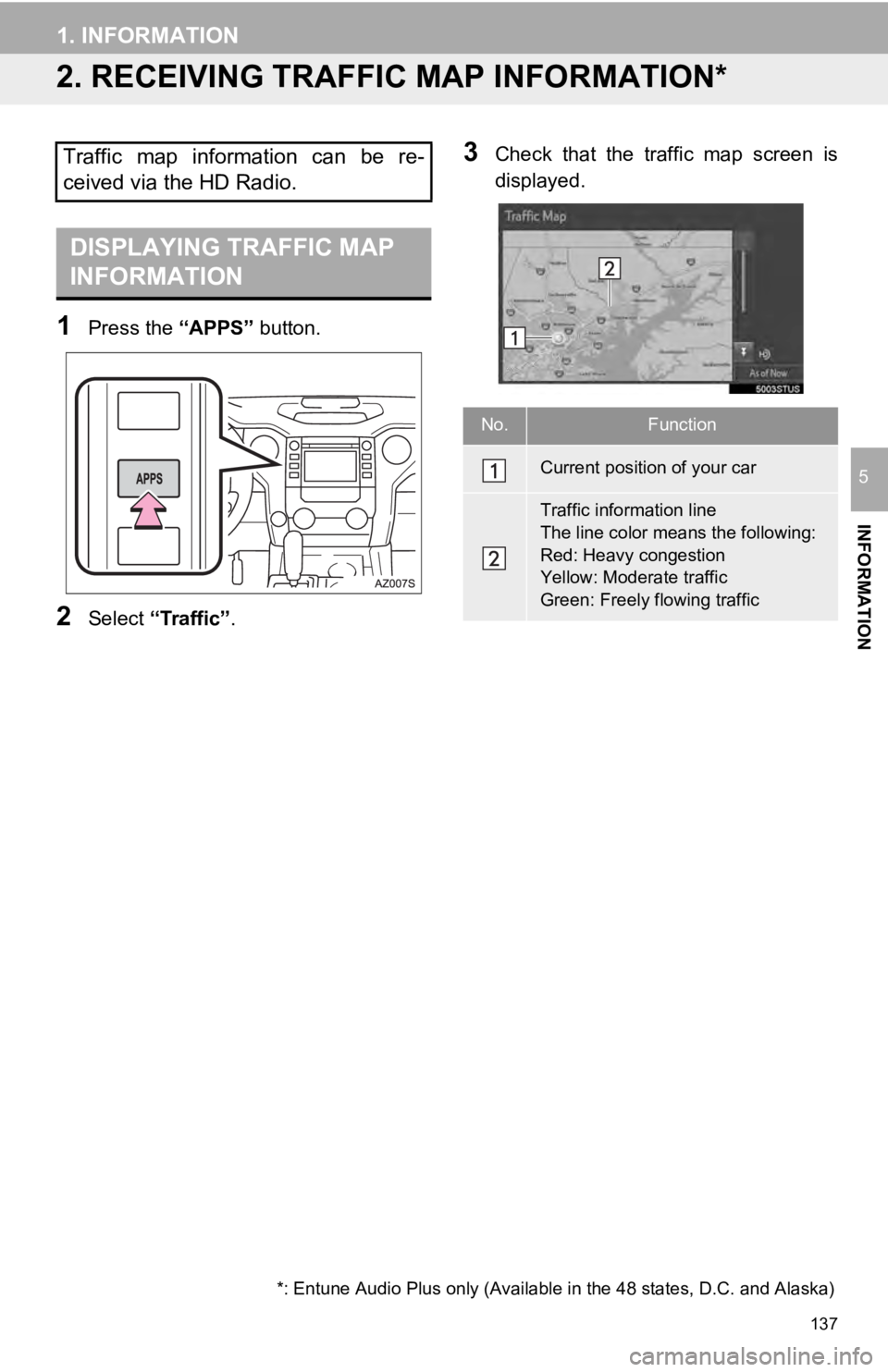
137
1. INFORMATION
INFORMATION
5
2. RECEIVING TRAFFIC MAP INFORMATION*
*: Entune Audio Plus only (Available in the 48 states, D.C. and Alaska)
DISPLAYING TRAFFIC MAP
INFORMATION
1Press the “APPS” button.
2Select “Traffic” .
3Check that the traffic map screen is
displayed.Traffic map information can be re-
ceived via the HD Radio.
No.Function
Current position of your car
Traffic information line
The line color means the following:
Red: Heavy congestion
Yellow: Moderate traffic
Green: Freely flowing traffic
Page 139 of 282
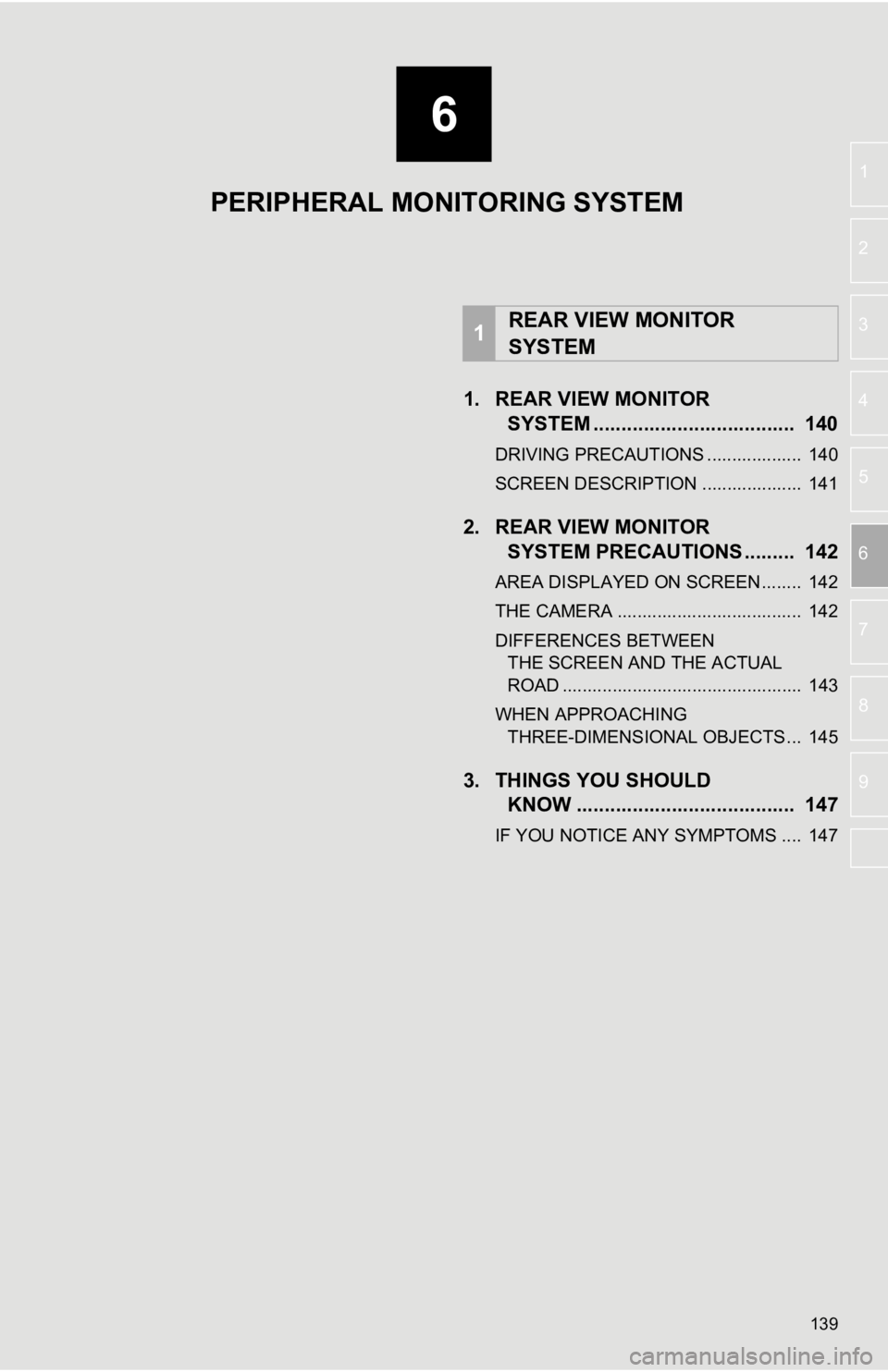
6
139
1
2
3
4
5
6
7
8
9
1. REAR VIEW MONITOR
SYSTEM .......... ....................... ...
140
DRIVING PRECAUTIONS ................... 140
SCREEN DESCRIPTION .................... 141
2. REAR VIEW MONITOR
SYSTEM PRECAUTIONS ......... 142
AREA DISPLAYED ON SCREEN........ 142
THE CAMERA ..................................... 142
DIFFERENCES BETWEEN
THE SCREEN AND THE ACTUAL
ROAD ................................................ 143
WHEN APPROACHING THREE-DIMENSIONAL OBJECTS ... 145
3. THINGS YOU SHOULD
KNOW ....................................... 147
IF YOU NOTICE ANY SYMPTOMS .... 147
1REAR VIEW MONITOR
SYSTEM
PERIPHERAL MONITORING SYSTEM
Page 140 of 282
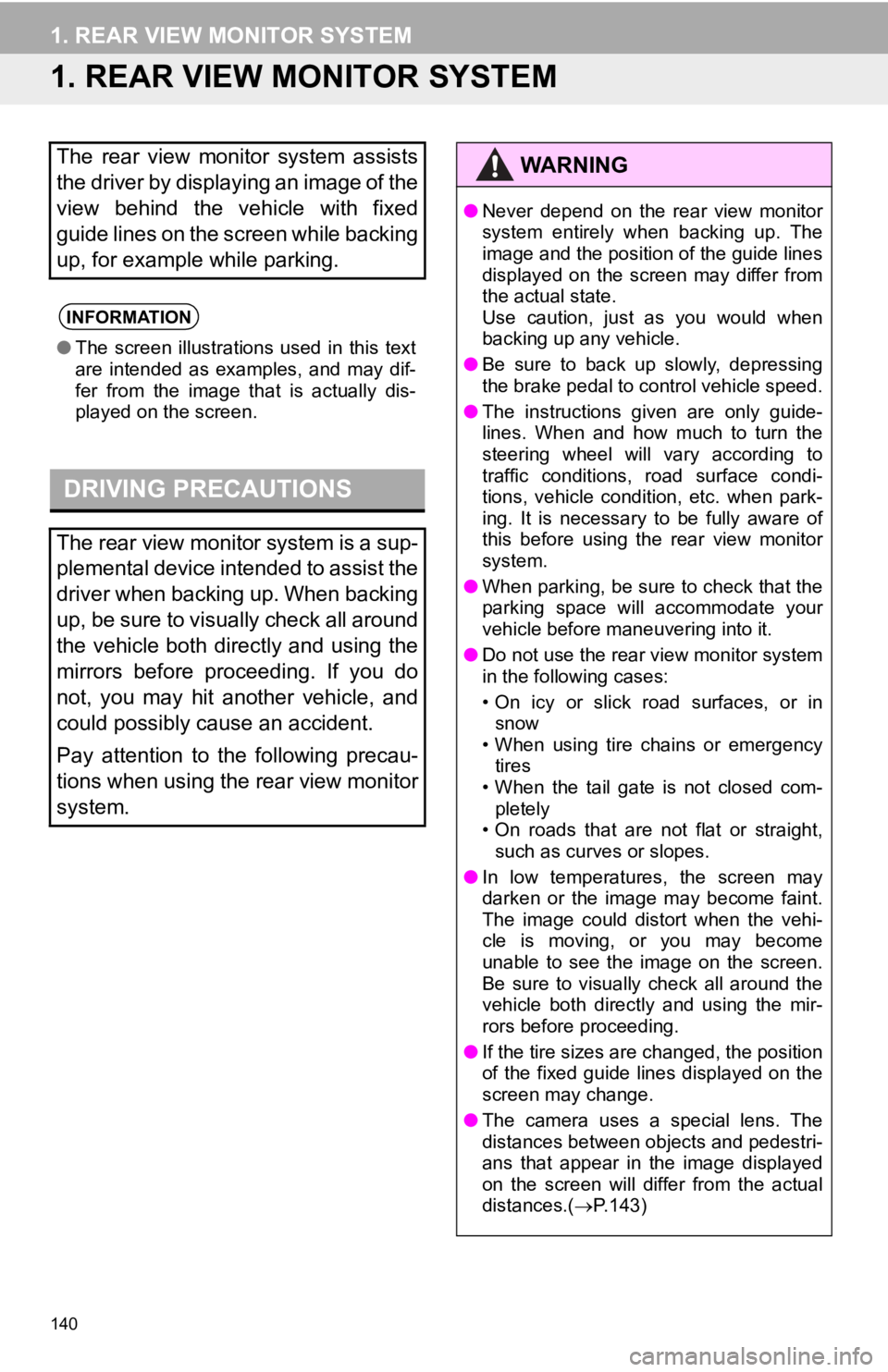
140
1. REAR VIEW MONITOR SYSTEM
1. REAR VIEW MONITOR SYSTEM
DRIVING PRECAUTIONS
The rear view monitor system assists
the driver by displaying an image of the
view behind the vehicle with fixed
guide lines on the screen while backing
up, for example while parking.
INFORMATION
● The screen illustrations used in this text
are intended as examples, and may dif-
fer from the image that is actually dis-
played on the screen.
The rear view monitor system is a sup-
plemental device intended to assist the
driver when backing up. When backing
up, be sure to visually check all around
the vehicle both directly and using the
mirrors before proceeding. If you do
not, you may hit another vehicle, and
could possibly cause an accident.
Pay attention to the following precau-
tions when using the rear view monitor
system.
WA R N I N G
● Never depend on the rear view monitor
system entirely when backing up. The
image and the position of the guide lines
displayed on the screen may differ from
the actual state.
Use caution, just as you would when
backing up any vehicle.
● Be sure to back up slowly, depressing
the brake pedal to control vehicle speed.
● The instructions given are only guide-
lines. When and how much to turn the
steering wheel will vary according to
traffic conditions, road surface condi-
tions, vehicle condition, etc. when park-
ing. It is necessary to be fully aware of
this before using the rear view monitor
system.
● When parking, be sure to check that the
parking space will accommodate your
vehicle before maneuvering into it.
● Do not use the rear view monitor system
in the following cases:
• On icy or slick road surfaces, or in
snow
• When using tire chains or emergency
tires
• When the tail gate is not closed com-
pletely
• On roads that are not flat or straight,
such as curves or slopes.
● In low temperatures, the screen may
darken or the image may become faint.
The image could distort when the vehi-
cle is moving, or you may become
unable to see the image on the screen.
Be sure to visually check all around the
vehicle both directly and using the mir-
rors before proceeding.
● If the tire sizes are changed, the position
of the fixed guide lines displayed on the
screen may change.
● The camera uses a special lens. The
distances between objects and pedestri-
ans that appear in the image displayed
on the screen will differ from the actual
distances.( P.143)
Page 141 of 282
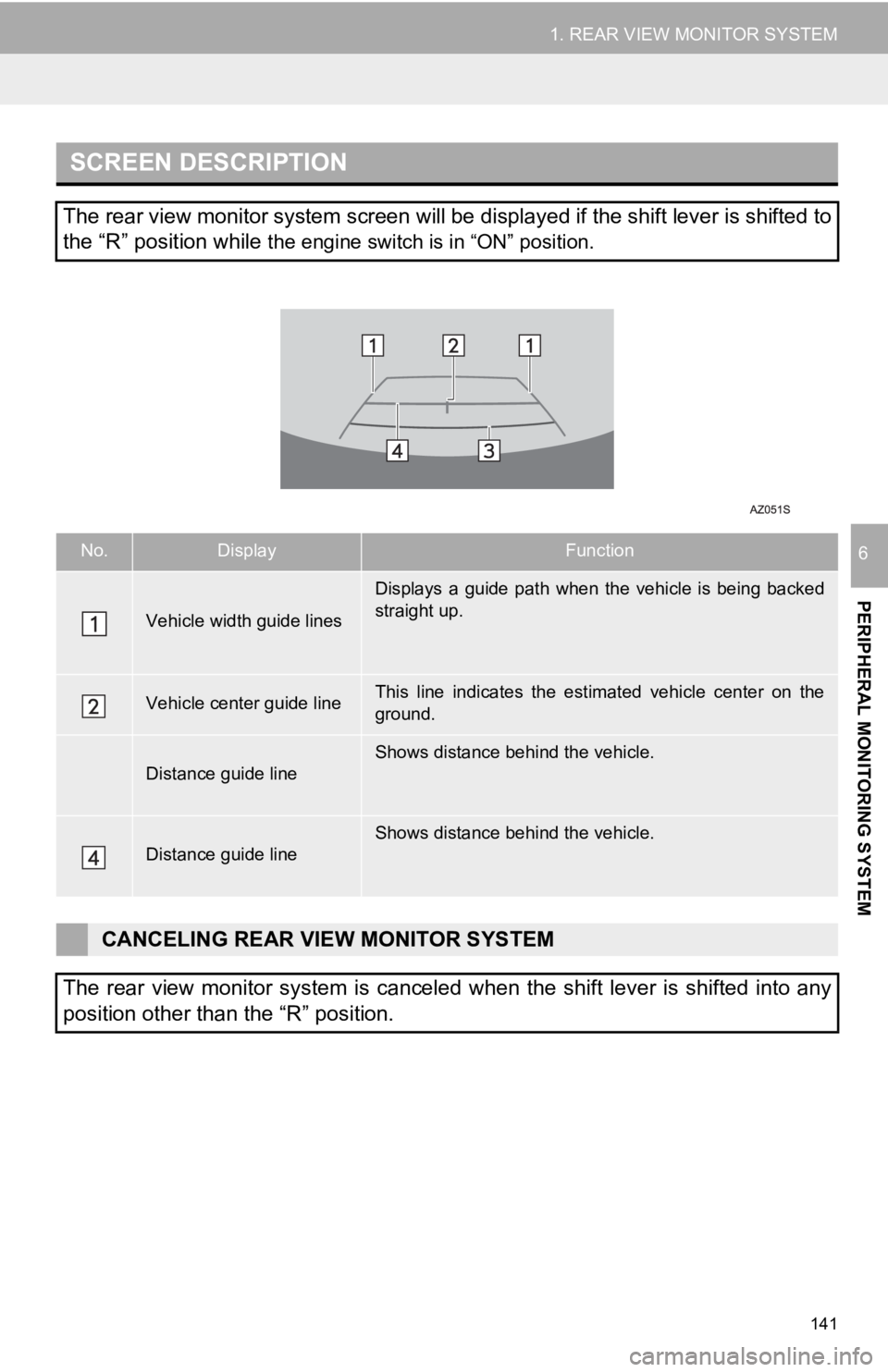
SCREEN DESCRIPTION
No.DisplayFunction
The displayed width is wider than the actual vehicle
width.
Displays a point approximately 1.5 ft. (0.5 m) (red) from
the edge of the bumper.
Displays a point approximatel y 3 ft. (1 m) (blue) from
the edge of the bumper.
141
1. REAR VIEW MONITOR SYSTEM
PERIPHERAL MONITORING SYSTEM
6
The rear view monitor system screen will be displayed if the sh ift lever is shifted to
the “R” position while
the engine switch is in “ON” position.
Vehicle width guide lines
Displays a guide path when t he vehicle is being backed
straight up.
Vehicle center guide lineThis line indicates the estimated vehicle center on the
ground.
Distance guide lineShows distance behind the vehicle.
Distance guide lineShows distance behind the vehicle.
CANCELING REAR VIEW MONITOR SYSTEM
The rear view monitor system is canceled when the shift lever i s shifted into any
position other than the “R” position.
Page 142 of 282
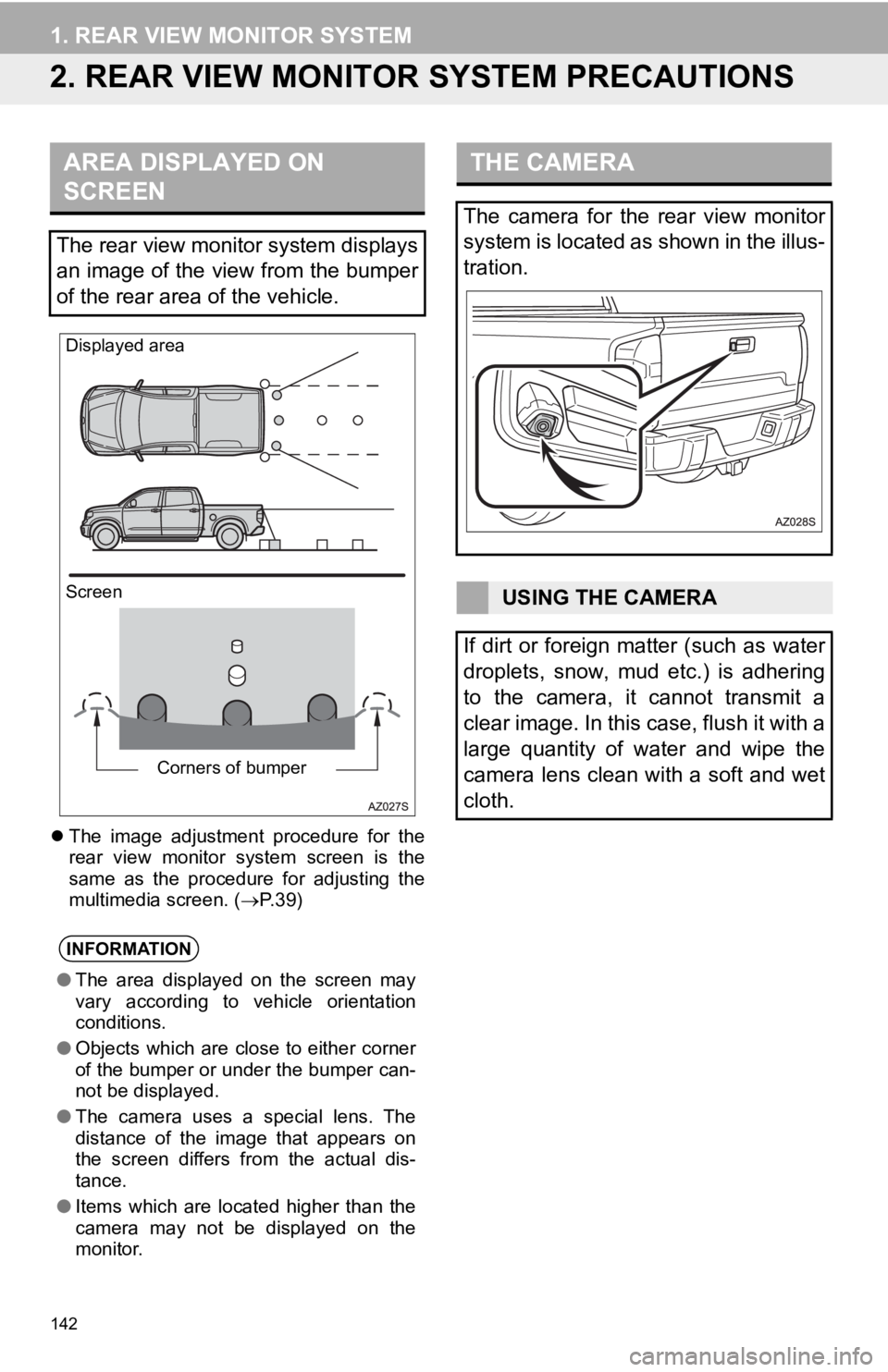
142
1. REAR VIEW MONITOR SYSTEM
2. REAR VIEW MONITOR SYSTEM PRECAUTIONS
AREA DISPLAYED ON
SCREEN
Screen Displayed area
Corners of bumper
The image adjustment procedure for the
rear view monitor system screen is the
same as the procedure for adjusting the
multimedia screen. ( P. 3 9 )
THE CAMERA
The rear view monitor system displays
an image of the view from the bumper
of the rear area of the vehicle.
INFORMATION
● The area displayed on the screen may
vary according to vehicle orientation
conditions.
● Objects which are close to either corner
of the bumper or under the bumper can-
not be displayed.
● The camera uses a special lens. The
distance of the image that appears on
the screen differs from the actual dis-
tance.
● Items which are located higher than the
camera may not be displayed on the
monitor.
The camera for the rear view monitor
system is located as shown in the illus-
tration.
USING THE CAMERA
If dirt or foreign matter (such as water
droplets, snow, mud etc.) is adhering
to the camera, it cannot transmit a
clear image. In this case, flush it with a
large quantity of water and wipe the
camera lens clean with a soft and wet
cloth.
Page 145 of 282
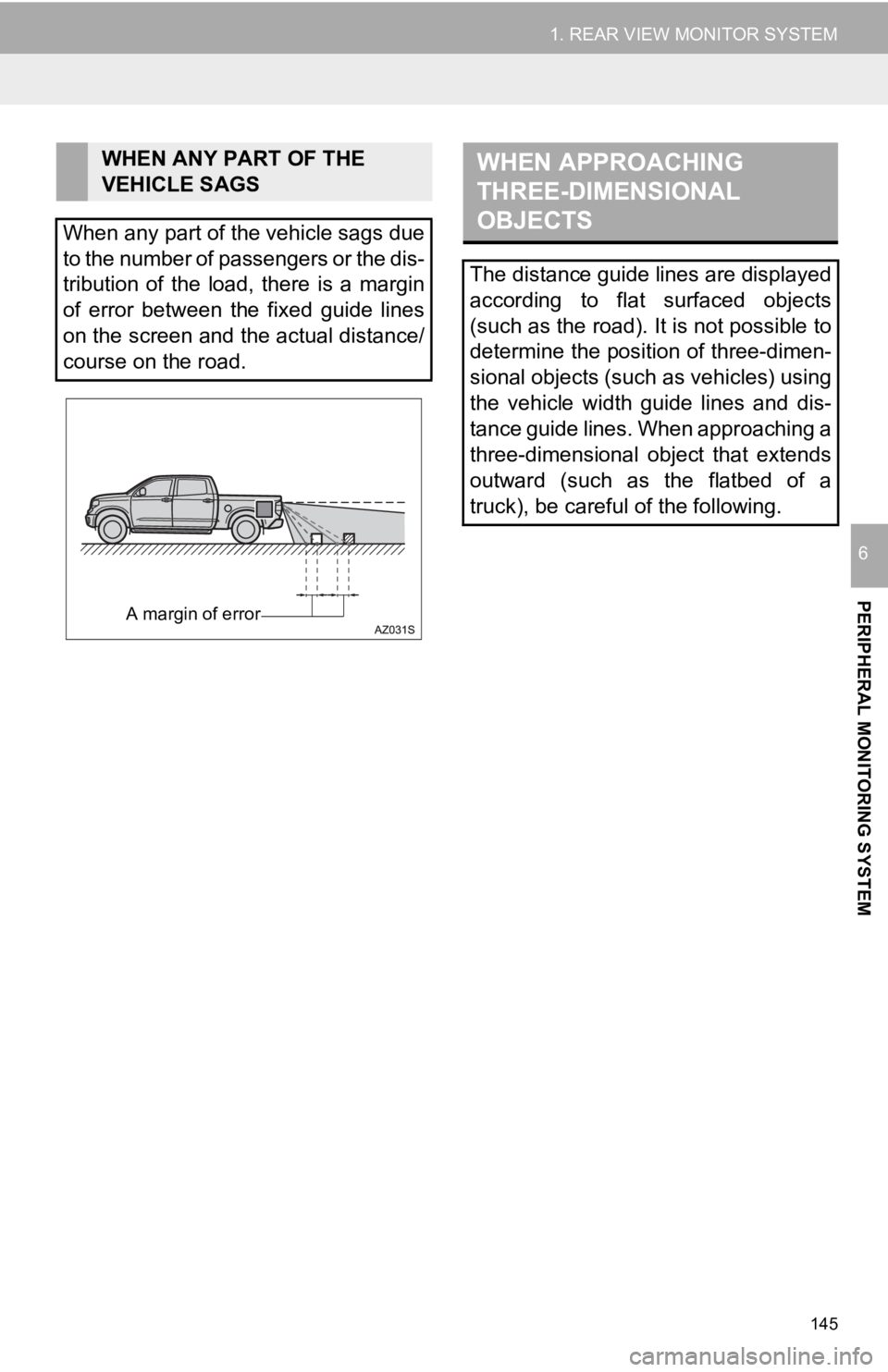
A margin of error
WHEN APPROACHING
THREE-DIMENSIONAL
OBJECTS
145
1. REAR VIEW MONITOR SYSTEM
PERIPHERAL MONITORING SYSTEM
6
WHEN ANY PART OF THE
VEHICLE SAGS
When any part of the vehicle sags due
to the number of passengers or the dis-
tribution of the load, there is a margin
of error between the fixed guide lines
on the screen and the actual distance/
course on the road.
The distance guide lines are displayed
according to flat surfaced objects
(such as the road). It is not possible to
determine the position of three-dimen-
sional objects (such as vehicles) using
the vehicle width guide lines and dis-
tance guide lines. When approaching a
three-dimensional object that extends
outward (such as the flatbed of a
truck), be careful of the following.
Page 149 of 282
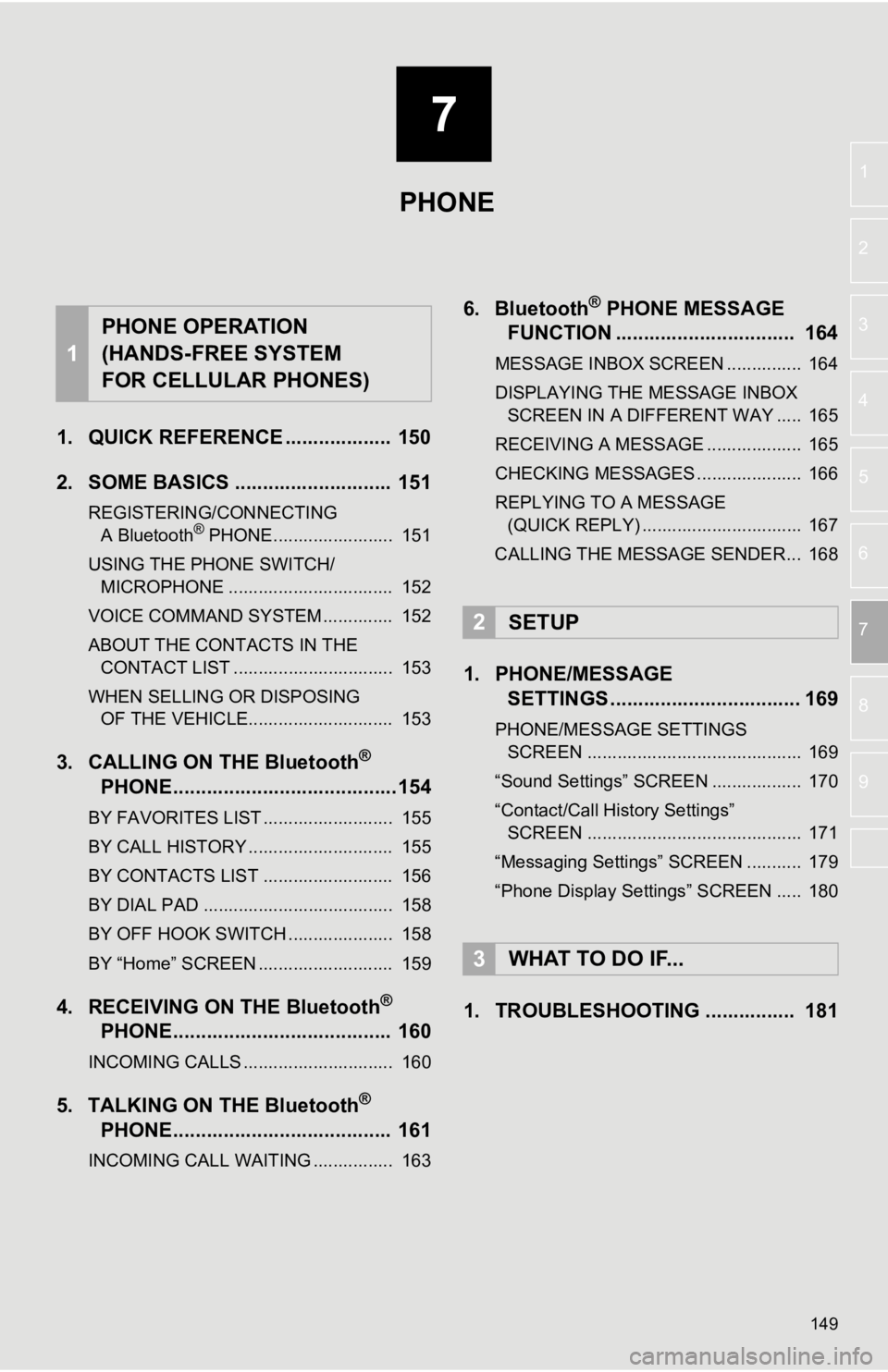
7
149
1
2
3
4
5
6
7
8
9
1. QUICK REFERENCE ................... 150
2. SOME BASICS ............................ 151
REGISTERING/CONNECTING
A Bluetooth® PHONE........................ 151
USING THE PHONE SWITCH/ MICROPHONE ................................. 152
VOICE COMMAND SYSTEM .............. 152
ABOUT THE CONTACTS IN THE CONTACT LIST ................................ 153
WHEN SELLING OR DISPOSING
OF THE VEHICLE............................. 153
3. CALLING ON THE Bluetooth®
PHONE........................................154
BY FAVORITES LIST .......................... 155
BY CALL HISTORY ............................. 155
BY CONTACTS LIST .......................... 156
BY DIAL PAD ...................................... 158
BY OFF HOOK SWITCH ..................... 158
BY “Home” SCREEN ........................... 159
4. RECEIVING ON THE Bluetooth®
PHONE....................................... 160
INCOMING CALLS .............................. 160
5. TALKING ON THE Bluetooth®
PHONE....................................... 161
INCOMING CALL WAITING ................ 163
6. Bluetooth® PHONE MESSAGE
FUNCTION ...... ....................... ...
164
MESSAGE INBOX SCREEN ............... 164
DISPLAYING THE MESSAGE INBOX
SCREEN IN A DIFFERENT WAY ..... 165
RECEIVING A MESSAGE ................... 165
CHECKING MESSAGES ..................... 166
REPLYING TO A MESSAGE
(QUICK REPLY) ................................ 167
CALLING THE MESSAGE SENDER... 168
1. PHONE/MESSAGE
SETTINGS .................................. 169
PHONE/MESSAGE SETTINGS
SCREEN ........................................... 169
“Sound Settings” SCREEN .................. 170
“Contact/Call History Settings”
SCREEN ........................................... 171
“Messaging Settings” SCREEN ........... 179
“Phone Display Settings” SCREEN ..... 180
1. TROUBLESHOOTING ................ 181
1
PHONE OPERATION
(HANDS-FREE SYSTEM
FOR CELLULAR PHONES)
2SETUP
3WHAT TO DO IF...
PHONE
Page 150 of 282
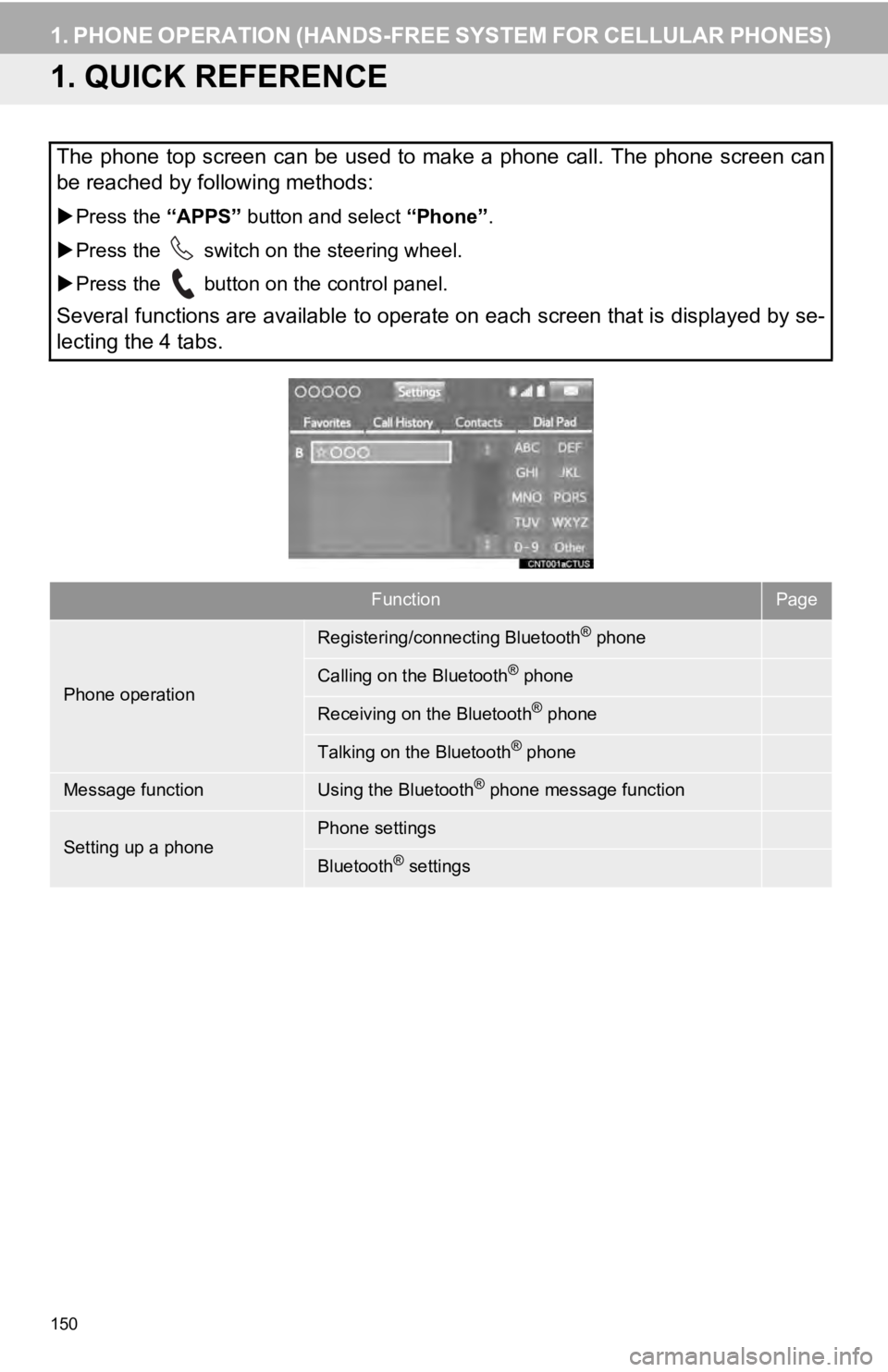
150
1. PHONE OPERATION (HANDS-FREE SYSTEM FOR CELLULAR PHONES)
1. QUICK REFERENCE
Press the “APPS” button and select “Phone” .
Press the
switch on the steering wheel.
Press the
button on the control panel.
FunctionPage
42
154
160
161
164
169
50
The phone top screen can be used to make a phone call. The phon e screen can
be reached by following methods:
Several functions are available to operate on each screen that is displayed by
se-
lecting the 4 tabs.
Phone operation
Registering/connecting Bluetooth® phone
Calling on the Bluetooth® phone
Receiving on the Bluetooth® phone
Talking on the Bluetooth® phone
Message functionUsing the Bluetooth® phone message function
Setting up a phonePhone settings
Bluetooth® settings
Page 151 of 282
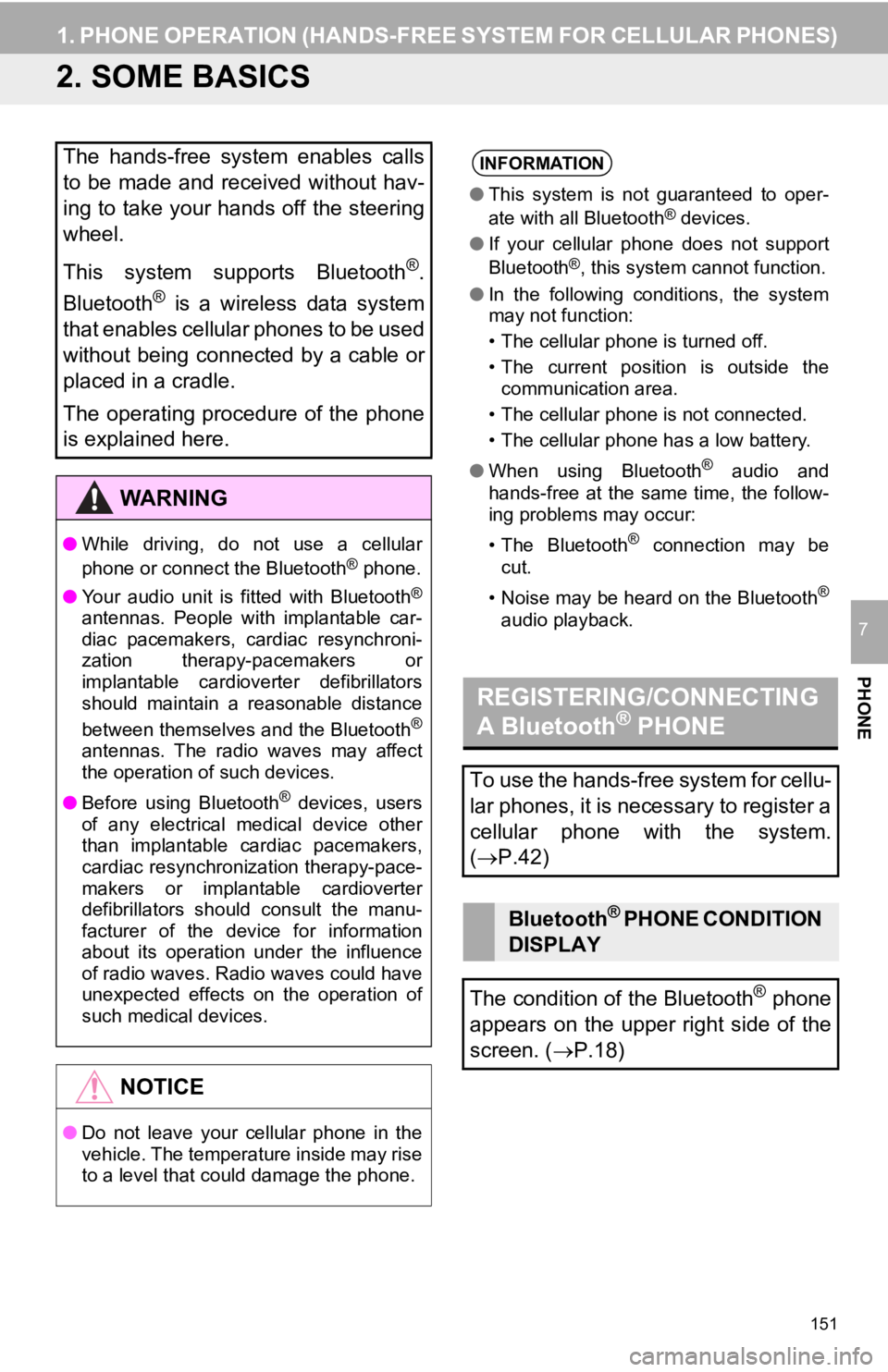
151
1. PHONE OPERATION (HANDS-FREE SYSTEM FOR CELLULAR PHONES)
PHONE
7
2. SOME BASICS
REGISTERING/CONNECTING
A Bluetooth® PHONE
The hands-free system enables calls
to be made and received without hav-
ing to take your hands off the steering
wheel.
This system supports Bluetooth
®.
Bluetooth
® is a wireless data system
that enables cellular phones to be used
without being connected by a cable or
placed in a cradle.
The operating procedure of the phone
is explained here.
WA R N I N G
● While driving, do not use a cellular
phone or connect the Bluetooth® phone.
● Your audio unit is fitted with Bluetooth
®
antennas. People with implantable car-
diac pacemakers, cardiac resynchroni-
zation therapy-pacemakers or
implantable cardioverter defibrillators
should maintain a reasonable distance
between themselves and the Bluetooth
®
antennas. The radio waves may affect
the operation of such devices.
● Before using Bluetooth
® devices, users
of any electrical medical device other
than implantable cardiac pacemakers,
cardiac resynchronization therapy-pace-
makers or implantable cardioverter
defibrillators should consult the manu-
facturer of the device for information
about its operation under the influence
of radio waves. Radio waves could have
unexpected effects on the operation of
such medical devices.
NOTICE
● Do not leave your cellular phone in the
vehicle. The temperature inside may rise
to a level that could damage the phone.
INFORMATION
● This system is not guaranteed to oper-
ate with all Bluetooth® devices.
● If your cellular phone does not support
Bluetooth
®, this system cannot function.
● In the following conditions, the system
may not function:
• The cellular phone is turned off.
• The current position is outside the
communication area.
• The cellular phone is not connected.
• The cellular phone has a low battery.
● When using Bluetooth
® audio and
hands-free at the same time, the follow-
ing problems may occur:
• The Bluetooth
® connection may be
cut.
• Noise may be heard on the Bluetooth
®
audio playback.
To use the hands-free system for cellu-
lar phones, it is necessary to register a
cellular phone with the system.
( P.42)
Bluetooth® P H O N E C O N D I T I O N
DISPLAY
The condition of the Bluetooth
® phone
appears on the upper right side of the
screen. ( P.18)
Page 154 of 282
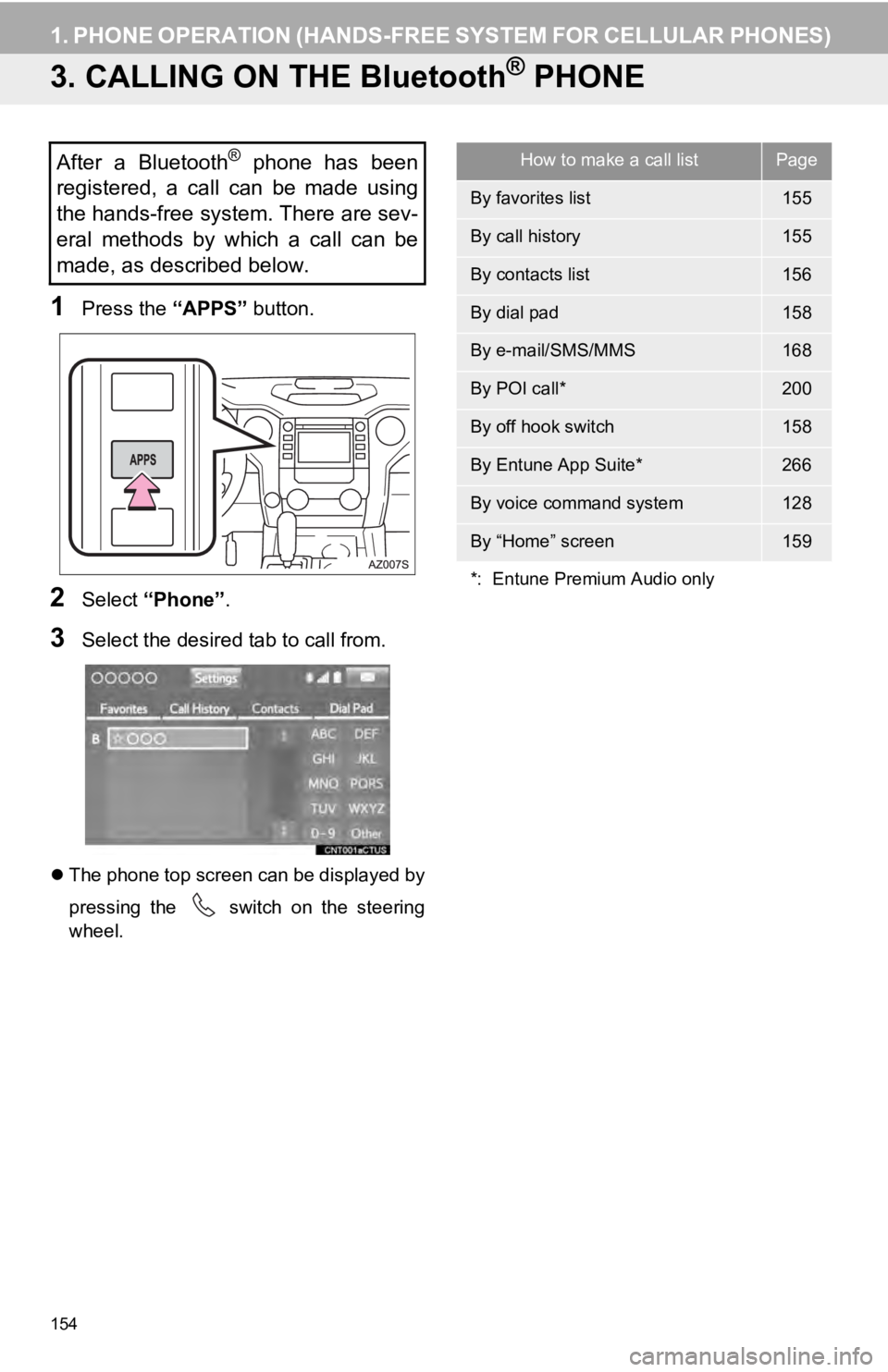
154
1. PHONE OPERATION (HANDS-FREE SYSTEM FOR CELLULAR PHONES)
3. CALLING ON THE Bluetooth® PHONE
1Press the “APPS” button.
2Select “Phone” .
3Select the desired tab to call from.
The phone top screen can be displayed by
pressing the
switch on the steering
wheel.
After a Bluetooth® phone has been
registered, a call can be made using
the hands-free system. There are sev-
eral methods by which a call can be
made, as described below.How to make a call listPage
By favorites list155
By call history155
By contacts list156
By dial pad158
By e-mail/SMS/MMS168
By POI call*200
By off hook switch158
By Entune App Suite*266
By voice command system128
By “Home” screen159
*: Entune Premium Audio only